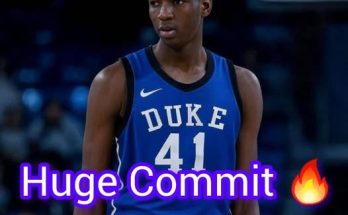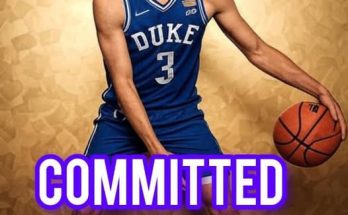Malakai Lee’s commitment could anchor a dominant and revamped Alabama offensive line in 2026, signaling a major shift in the Crimson Tide’s future trench warfare. While Alabama is no stranger to securing top-tier offensive linemen, Lee’s decision to don the Crimson and White brings a different kind of momentum—one that speaks not just to his potential, but to the direction Alabama’s recruiting and development strategy is headed. At 6-foot-6 and 295 pounds, Lee possesses the raw physical tools, football intelligence, and relentless work ethic that make him an ideal building block for the next generation of Alabama offensive linemen.
In recent seasons, Alabama’s offensive line has seen both high points and stretches of inconsistency, particularly with the transitions that came after the Nick Saban era. Now under the leadership of head coach Kalen DeBoer and his revamped staff, the Tide are in the process of building a new identity—one that leans on balance, physicality, and technical precision up front. Lee fits that blueprint seamlessly. His commitment gives Alabama not just another body on the depth chart, but a potential future leader in the trenches, someone who could anchor the line for years and become a cornerstone of the 2026 offense.
What makes Lee so intriguing is how well-rounded he is at this stage in his development. While many linemen at the high school level rely solely on size or brute strength, Lee combines those physical gifts with a refined skill set. His footwork is nimble for a player his size, allowing him to mirror edge rushers and maintain solid pass protection. He plays with leverage and pad level in the run game, opening lanes and finishing blocks with a nasty edge that coaches love. Lee’s tape is filled with moments that show dominance, but also discipline—traits that translate well to the SEC level.
From a recruiting perspective, Lee’s commitment represents a significant win for Alabama in a fiercely competitive landscape. Programs across the SEC and beyond had Lee on their radar, and landing him speaks volumes about the trust he places in Alabama’s development program. In a time when NIL opportunities, early playing time, and flashy branding are influencing commitments, Alabama’s ability to sell development, legacy, and winning remains a powerful draw. Lee’s commitment reinforces that reputation.
It also sends a message to other elite offensive linemen in the 2026 class. When a top-tier talent like Lee commits early, it sets the tone. He becomes a potential recruiter himself, attracting others to follow suit and buy into the vision. If Alabama is able to build around him with complementary pieces—another tackle, a powerful interior lineman, or a dynamic center—the foundation for a championship-caliber unit will be in place.
From a scheme standpoint, Lee is an ideal fit for what Alabama appears to be building offensively. DeBoer’s system emphasizes balance, tempo, and unpredictability, requiring linemen who can do it all—pass protect against elite rushers, pull in space on screens and sweeps, and anchor down in short-yardage situations. Lee’s versatility allows for all of that. He could slot in at left tackle down the road, protecting the quarterback’s blindside, or potentially shift inside depending on team needs. That type of flexibility makes him even more valuable in a college system where adaptability is key.
What truly elevates Lee’s projection, though, is his mindset. Coaches and evaluators rave about his maturity, leadership, and hunger to improve. He’s known to be the first one on the field and the last one off it. He watches film like a seasoned veteran, constantly looking to clean up technique and understand opponent tendencies. That approach to the game—combined with elite measurables—makes him a prime candidate to play early and develop into a multi-year starter.
Alabama’s coaching staff has made it clear they are investing heavily in the trenches for the 2026 cycle. In the modern SEC, where games are increasingly decided at the line of scrimmage, stockpiling blue-chip offensive linemen is more than a luxury—it’s a necessity. Lee’s commitment not only meets that need, it helps set a standard. He gives the Tide a clear-cut anchor around which the rest of the unit can be structured. Whether Alabama wants to run a downhill power scheme, stretch the field with outside zone, or go pass-heavy, Lee’s presence gives them options.
Looking ahead to 2026, it’s not hard to imagine Lee stepping into a significant role as a true freshman. While the transition from high school to the SEC is never easy, Lee’s physical readiness and mental makeup put him ahead of the curve. If Alabama’s strength and conditioning program can add to his already impressive frame, and if he continues to refine his technique, he could be in the rotation from Day 1—perhaps even pushing for a starting spot depending on roster turnover and injuries.
His presence could also open doors for offensive coordinators to be more creative. A stable, dominant offensive line allows for more flexibility in play-calling. Quarterbacks can be more confident in the pocket. Running backs have more room to operate. Explosive plays become more frequent. Lee’s ability to handle one-on-one matchups, seal edges, and win leverage battles gives the Tide a strategic advantage.
On the flip side, his commitment also applies pressure to the rest of the 2026 class to keep up. Alabama is known for competition, and Lee’s arrival raises the bar. Other linemen will need to bring their best if they want to earn snaps. That internal competition drives excellence and raises the level of the entire unit. In this way, Lee isn’t just a standout player—he’s a catalyst for culture.
Beyond football, Lee’s decision also reflects the kind of student-athlete Alabama continues to target. Known for his academic discipline and strong character, he brings more than just football skills to Tuscaloosa. He fits the mold of a program-builder—someone who leads by example, holds others accountable, and represents the university with class. In the age of the transfer portal and NIL-driven drama, Lee’s stability is refreshing and important.
His commitment also serves as a reminder of Alabama’s staying power in the recruiting world. While other programs make headlines with splashy social media campaigns or short-term buzz, Alabama continues to land players like Lee—blue-collar stars who thrive in development systems and stick around long enough to make a real impact. These are the types of commitments that don’t just win games—they win championships.
In the bigger picture, if Alabama is able to surround Lee with the right coaching, complementary talent, and strength training, he could leave Tuscaloosa as an NFL first-round pick. The tools are there. The mindset is there. And now, the opportunity is there. The path to dominance isn’t easy in the SEC, but Lee looks like someone who not only embraces that challenge—he thrives in it.
Alabama fans have every reason to be excited. The 2026 season may still be over a year away, but Malakai Lee’s commitment gives them something concrete to look forward to. He represents a return to form in the trenches, a recommitment to physical dominance, and a beacon of what the future could look like under this new coaching regime. If things go according to plan, Lee won’t just be a name on the roster—he’ll be a fixture on highlight reels, draft boards, and, potentially, championship stages.



